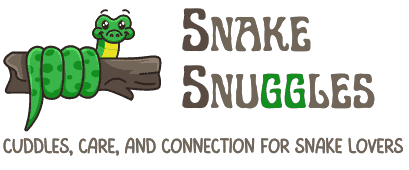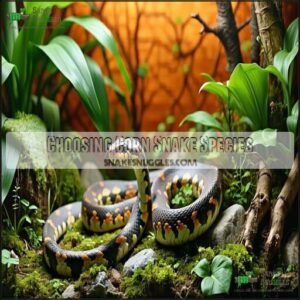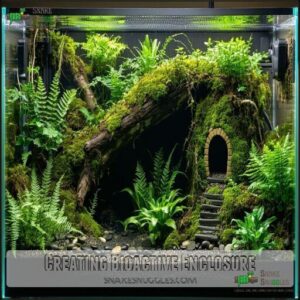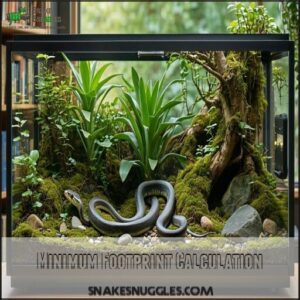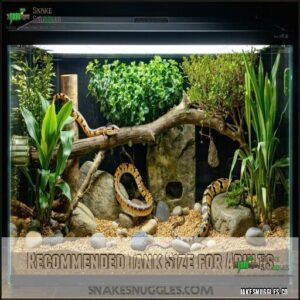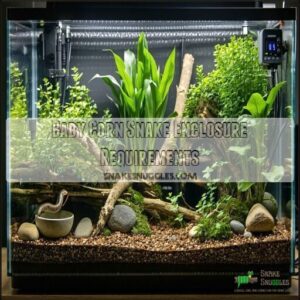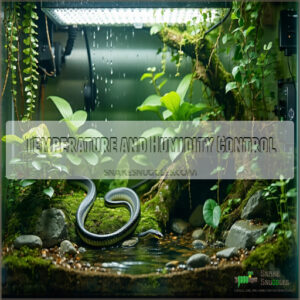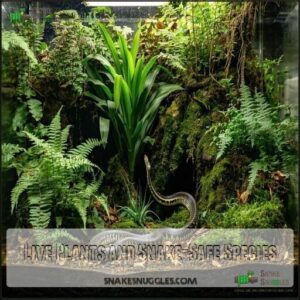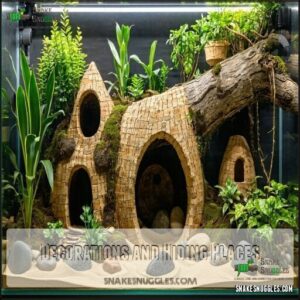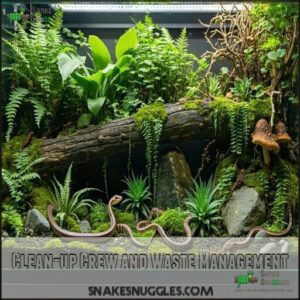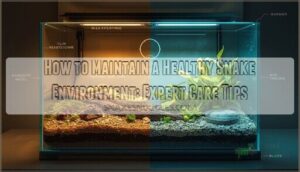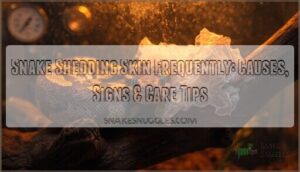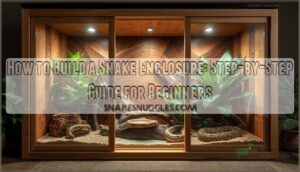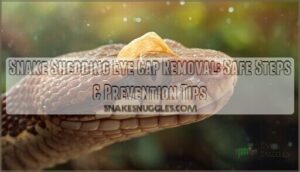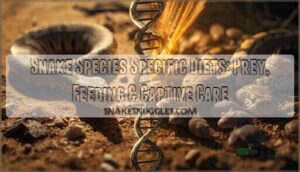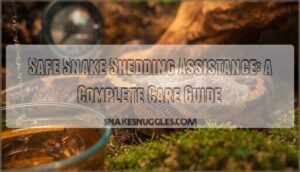This site is supported by our readers. We may earn a commission, at no cost to you, if you purchase through links.
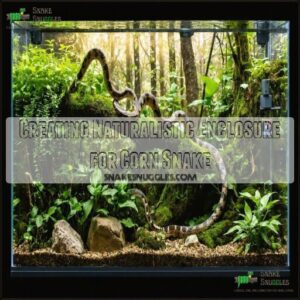
Start by choosing a suitable substrate, like aspen or coconut fiber, and add some hiding spots.
Introduce live plants to create a bioactive environment.
Consider a 40-gallon breeder tank for adults, with a temperature gradient and humidity control.
Don’t forget enrichment items like climbing branches.
You’re on the right track, and with a few more tweaks, you’ll have a thriving ecosystem – let’s get started on designing the perfect habitat for your slithery friend.
Table Of Contents
- Key Takeaways
- Choosing Corn Snake Species
- Creating Bioactive Enclosure
- Enclosure Size and Design
- Temperature and Humidity Control
- Environmental Enrichment and Decor
- Frequently Asked Questions (FAQs)
- How do you make a corn snake natural setup?
- How do you make a bioactive corn snake enclosure?
- What is the best enclosure for a corn snake?
- What is a corn snakes natural habitat?
- How often feed corn snakes in captivity?
- What size water bowl is recommended?
- Can corn snakes swim in deep water?
- How to introduce new snakes safely?
- What are signs of stress in corn snakes?
- Conclusion
Key Takeaways
- You’ll create a naturalistic enclosure for your corn snake by selecting a suitable substrate, like aspen or coconut fiber, and adding hiding spots to mimic its native habitat.
- To ensure a thriving ecosystem, you’ll introduce live plants, maintain a temperature gradient, and control humidity levels between 40-60% using misting techniques and a hygrometer.
- You’ll choose a tank that’s at least 0.7 times the snake’s length by 0.5 times its length, with a minimum size of 40 gallons for adults, and include decorations like cork, hiding caves, and rock hides to provide ample space and hiding spots.
- By following guidelines like feeding your corn snake every 7-10 days, providing a shallow water bowl, and introducing new snakes safely through quarantine and gradual introduction, you’ll build a balanced environment that meets your pet’s needs and helps it flourish.
Choosing Corn Snake Species
You’re choosing a corn snake species to create a naturalistic enclosure, considering factors like temperament and adaptability.
You’ll select a species that thrives in bioactive setups, mimicking its native habitat and ensuring a healthy, engaging environment.
Temperament and Handling Ease
You’ll encounter various corn snake personalities.
Consider these handling tips:
- Research snake behavior
- Understand temperament types
- Note ease factors
- Observe snake personality
Learning about corn snake temperament is crucial for creating a suitable environment, and you can find more information on corn snake temperament.
Understanding the importance of a naturalistic terrarium and ensuring a safe corn snake habitat and reptile enclosure is key to providing the best care for your pet.
Adaptability to Bioactive Setups
You’re considering a bioactive setup for your corn snake.
Bioactive benefits include microbial balance and ecosystem dynamics.
A naturalistic terrarium with proper substrate depth supports snake behavior, creating a thriving corn snake habitat with a bioactive substrate, promoting a healthy naturalistic habitat.
Native Habitat and Distribution
Corn snakes have a geographic range primarily in the southeastern US, with a wild distribution stretching from Louisiana to North Carolina.
Their native habitat includes a diverse mix of environments:
- Hardwood forests
- Pine forests
- Mixed forests
- Fields and wetlands
- Farms and disturbed areas
Scattered populations of corn snakes have also been found as far north as New Jersey, showcasing their ability to adapt to different regions and thrive in various environments.
Creating Bioactive Enclosure
You’re creating a bioactive enclosure for your corn snake, which involves selecting the right substrate and drainage layer to mimic its natural habitat.
By choosing the correct materials and setting up the enclosure properly, you’ll be able to provide your snake with a healthy and thriving environment.
Substrate Selection and Depth
Select a substrate that mimics your corn snake’s natural habitat.
A 3-4" deep soil mix with organic layers supports burrowing and moisture control. Aspen bedding or coconut fiber are substrate options, but a bioactive substrate is ideal for a naturalistic enclosure, promoting a healthy environment for your pet.
For superior results, consider using a good corn snake substrate that meets the specific needs of your pet, supporting burrowing and moisture control.
Drainage Layer and Moisture Control
You’ll want a drainage layer, like LECA, to prevent waterlogging.
This 1-2" layer helps control moisture levels, maintaining a stable water table.
Proper substrate depth and LECA layers facilitate effective drainage and humidity control in your bioactive enclosure.
Effective bioactive substrate management is vital for maintaining a healthy environment.
Bioactive Substrate Ingredients
When creating a bioactive substrate, you’ll mix topsoil, peat moss, and coconut fiber, adding organic matter to support microbial life, atop a LECA layer, offering various substrate options for a naturalistic decor with live plants.
To achieve the best results, consider using a bioactive mixture that includes components like peat moss and perlite for ideal drainage and plant growth.
Enclosure Size and Design
You’ll need to calculate the minimum footprint for your corn snake’s enclosure based on its length.
A good rule of thumb is to provide an enclosure that’s at least 0.7 times the snake’s length by 0.5 times its length, so you can give your pet plenty of space to move around, which is a key factor in ensuring the snake’s overall health and well-being and providing a suitable environment for it to thrive.
Minimum Footprint Calculation
To determine your snake’s minimum enclosure size, use the Footprint Formula: Length x Width.
Calculate 0.7 x snake length and 0.5 x snake length for the minimum space, ensuring adequate growth factor in your reptile tank setup, like a corn snake enclosure, with proper enclosure dimensions.
For ball pythons, consider appropriate ball python enclosure dimensions based on age and size.
Recommended Tank Size for Adults
For adult corn snakes, a 40-gallon breeder tank provides ample space, considering growth potential and upgrade considerations.
With minimum dimensions of 36” x 18” x 18” for a suitable corn snake enclosure size, making it an ideal tank size for an adult corn snake‘s habitat.
Baby Corn Snake Enclosure Requirements
For baby corn snakes, a 10-20 gallon tank is ideal, with a substrate depth of 1-2 inches.
Maintaining a temperature gradient and humidity control, providing hiding spots, and a suitable tank setup for their growth, ensuring a healthy environment in their corn snake tank, is crucial for their development, and a temperature gradient is key to this.
Temperature and Humidity Control
You’ll need to control temperature and humidity to create a naturalistic enclosure for your corn snake.
By setting up a temperature gradient and maintaining ideal humidity levels, you can replicate your snake’s natural environment and keep it healthy.
Temperature Gradient and Heat Sources
You’ll set up a temperature gradient with heat sources, using heat mats and a thermostat for control.
This setup creates basking spots and a thermal gradient for your corn snake’s thermoregulation, ensuring a healthy environment.
With precise temperature control and heat sources, you can provide the optimal conditions for your corn snake.
Humidity Levels and Maintenance
You’ll maintain ideal humidity levels between 40-60% using misting techniques and a hygrometer for monitoring, ensuring a healthy environment with humid hideaways for your corn snake.
While also employing water cycling and mist systems for effective humidity control.
UVB Lighting and Replacement
You’ll need UVB lighting for your corn snake’s health, providing vitamin D and stimulating appetite.
Choose low-strength options like Arcadia, and replace every 12 months for maximum UVB benefits.
Following proper replacement schedules and lighting cycles is crucial to guarantee lighting safety in your reptile lighting setup.
Environmental Enrichment and Decor
You’re creating a naturalistic enclosure for your corn snake, and now it’s time to focus on environmental enrichment and decor.
You’ll be adding live plants, decorations, and a clean-up crew to make your snake’s home feel more like its natural habitat.
Live Plants and Snake-Safe Species
When creating a naturalistic enclosure, choose live plants that are snake-safe, considering toxicity concerns and substrate impact.
Safe plant options like terrarium plants provide humidity benefits, making your bioactive enclosure thrive.
Select plants that fit your corn snake’s needs, ensuring a healthy environment. To create an ideal environment, understanding plant selection criteria is essential for the well-being of your pet.
Decorations and Hiding Places
You’ll add Cork Decor, Hiding Caves, and Rock Hides to create hiding spots.
The use of reptile hides can enhance the overall environment, making your reptile’s enclosure feel like home with these decorations.
Branch Climbing and Plant Selection also provide snake hiding places.
Clean-up Crew and Waste Management
You’ll manage waste with a cleanup crew.
Here are key helpers:
- Springtails
- Isopods
- Fungi
- Bioactive plants
- Microfauna, ensuring a healthy bioactive enclosure with proper Springtail Care and Isopod Management for Waste Reduction.
Frequently Asked Questions (FAQs)
How do you make a corn snake natural setup?
What’s the secret to a thriving corn snake setup? You’ll design a naturalistic environment with proper temperature, humidity, and substrate, mimicking their southeastern US habitat for peak health.
How do you make a bioactive corn snake enclosure?
You’ll set up a bioactive corn snake enclosure by layering LECA, bioactive substrate, and decorations, maintaining ideal temperature, humidity, and lighting for a thriving ecosystem.
What is the best enclosure for a corn snake?
You’ll need a 40-gallon tank with a temperature gradient, humidity control, and hiding spots for your corn snake, providing ample space to stretch and roam comfortably.
What is a corn snakes natural habitat?
You’ll find corn snakes in southeastern US habitats, including forests, fields, and wetlands.
They have a range stretching from Louisiana to North Carolina and scattered pockets as far north as New Jersey, which is a significant part of their geographic distribution.
How often feed corn snakes in captivity?
You’ll feed corn snakes in captivity every 7-10 days, depending on age, size, and activity level.
Offering prey items like mice or rats that are about 1-5 times their head width.
What size water bowl is recommended?
Imagine a tiny oasis, you’ll want a water bowl that’s about 4-6 inches in diameter, large enough for your corn snake to drink and soak comfortably, without overwhelming the enclosure.
Can corn snakes swim in deep water?
You can provide a shallow water bowl, as corn snakes are capable swimmers, but they don’t require deep water, and it’s vital to make certain their safety and comfort.
How to introduce new snakes safely?
You’ll introduce new snakes safely by quarantining them, monitoring health, and gradual introduction to prevent stress and disease transmission, ensuring a smooth integration to their new environment.
What are signs of stress in corn snakes?
You’re a detective, and stressed corn snakes are your mystery to solve, showing signs like pacing, hissing, or hiding excessively, indicating discomfort or fear in their environment suddenly.
Conclusion
You’re crafting a haven for your pet by creating a naturalistic enclosure for corn snake, where they’ll thrive.
With a balanced environment and proper care, your snake will flourish.
By following these guidelines, you’ll build a thriving ecosystem, giving your corn snake a happy, healthy home, making creating a naturalistic enclosure for corn snake a rewarding experience.
- https://www.visionproducts.us/blog/corn-snakes/
- https://www.zenhabitats.com/blogs/reptile-care-sheets-resources/corn-snake-complete-lighting-and-heating-guide
- https://www.reptilecentre.com/blogs/reptile-blog/5-awesome-decorations-for-a-corn-snake
- https://reptifiles.com/corn-snake-care/
- https://community.morphmarket.com/
